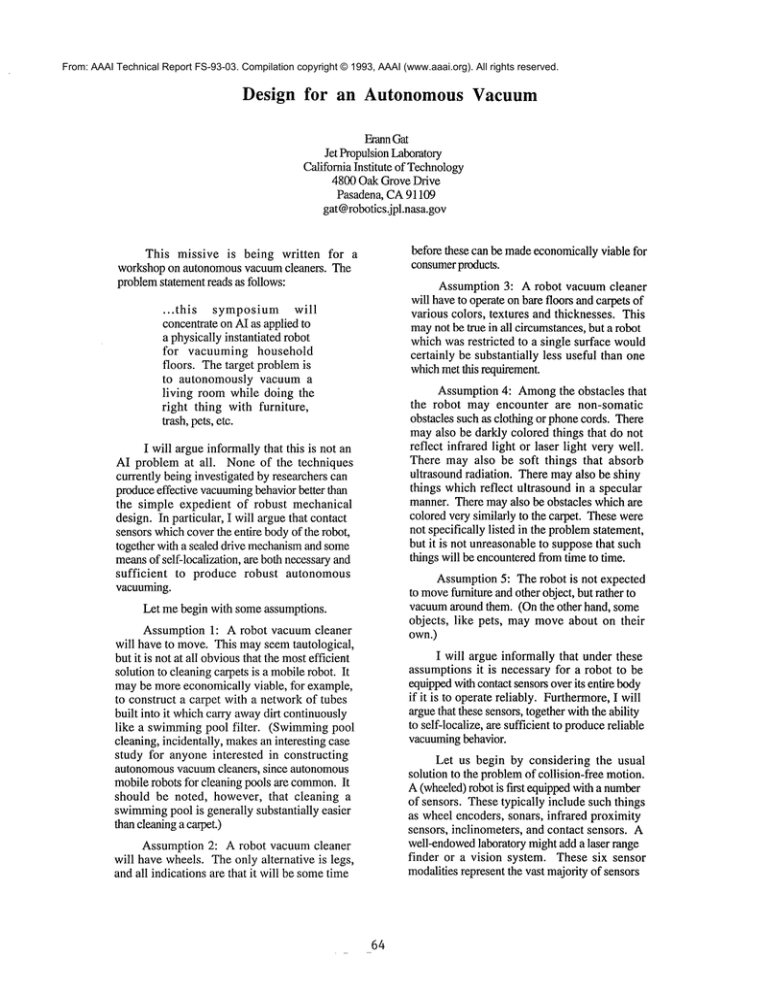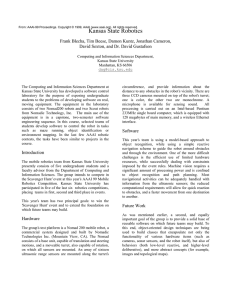
From: AAAI Technical Report FS-93-03. Compilation copyright © 1993, AAAI (www.aaai.org). All rights reserved.
Design for an Autonomous Vacuum
EvannGat
Jet PropulsionLaboratory
California Institute of Technology
4800 Oak Grove Drive
Pasadena, CA91109
gat@robotics.jpl.nasa.gov
before these can be madeeconomicallyviable for
consumerproducts.
This missive is being written for a
workshopon autonomousvacuumcleaners. The
problemstatement reads as follows:
Assumption 3: A robot vacuum cleaner
will haveto operate on bare floors and carpets of
various colors, textures and thicknesses. This
maynot be true in all circumstances,but a robot
which was restricted to a single surface would
certainly be substantially less useful than one
whichmetthis requirement.
¯ ..this
symposium will
concentrateon AI as applied to
a physically instantiated robot
for vacuuming household
floors. The target problemis
to autonomously vacuum a
living room while doing the
right thing with furniture,
trash, pets, etc.
Assumption4: Amongthe obstacles that
the robot may encounter are non-somatic
obstacles such as clothing or phonecords. There
mayalso be darkly colored things that do not
reflect infrared light or laser light very well.
There may also be soft things that absorb
ultrasound radiation. There mayalso be shiny
things whichreflect ultrasound in a specular
manner. There mayalso be obstacles which are
colored very similarly to the carpet. Thesewere
not specifically listed in the problemstatement,
but it is not unreasonableto supposethat such
things will be encounteredfromtime to time.
I will argue informally that this is not an
AI problem at all. None of the techniques
currently being investigated by researchers can
produceeffective vacuuming
behaviorbetter than
the simple expedient of robust mechanical
design. In particular, I will argue that contact
sensors whichcover the entire bodyof the robot,
together with a sealed drive mechanism
and some
meansof self-localization, are both necessaryand
sufficient
to produce robust autonomous
vacuuming.
Assumption5: The robot is not expected
to movefurniture and other object, but rather to
vacuumaround them. (On the other hand, some
objects, like pets, maymoveabout on their
Let me begin with someassumptions.
Assumption 1: A robot vacuum cleaner
will have to move¯This mayseemtautological,
but it is not at all obviousthat the mostefficient
solution to cleaningcarpets is a mobilerobot. It
maybe more economically viable, for example,
to construct a carpet with a networkof tubes
built into it whichcarry awaydirt continuously
like a swimmingpool filter. (Swimmingpool
cleaning, incidentally, makesan interesting case
study for anyone interested in constructing
autonomousvacuumcleaners, since autonomous
mobilerobots for cleaning pools are common.
It
should be noted, however, that cleaning a
swimming
pool is generally substantially easier
than cleaninga carpet.)
own.)
I will argue informally that under these
assumptions it is necessary for a robot to be
equippedwith contactsensors over its entire body
if it is to operate reliably. Furthermore,I will
arguethat these sensors, togetherwiththe ability
to self-localize, are sufficient to producereliable
vacuumingbehavior.
Let us begin by considering the usual
solution to the problemof collision-free motion.
A (wheeled)robot is first equippedwith a number
of sensors. Thesetypically include such things
as wheel encoders, sonars, infrared proximity
sensors, inclinometers, and contact sensors. A
well-endowed
laboratory mightadd a laser range
finder or a vision system. These six sensor
modalities represent the vast majorityof sensors
Assumption 2: A robot vacuum cleaner
will have wheels. The only alternative is legs,
and all indications are that it will be sometime
64
currently in use on mobile robots in research
laboratories.
partially exposedin order to makecontact with
the ground. However, there is at least one
commercial
robot design (currently in prototype)
whichcomesvery close to the ideal. This design
(from Real World Interface) consists of
cylindrical synchrodrive robot with a housing
that coversthe gear train for eachdrive wheel.A
bottom plate covers the maindrive mechanism.
Thereare three circular hole in the bottomplate
which expose the wheels. Each wheel is fitted
with a circular cover plate which matchesthe
contour of the hole. This mechanismis still
vulnerable to jammingby very fine obstacles (a
discardedpiece of dental floss, for example)but
shouldbe robust in the presenceof socks.
Most of the commonlyused sensors and
strategies for avoidingobstacles will fail under
the stated assumptions. None of the sensor
modalities commonly
in use can reliably detect
all of the classes of obstacles which are
commonlyfound in household environments.
Sonarsfail on soft objects and specular objects.
Contact sensors fail on non-somaticobstacles.
Emissivesensors like laser ranger finders fail on
dark objects (and are expensive and hazardous
besides).
Vision is conceptually the most promising
obstacle sensing technology. Weappear to have
an existence proof of the adequacyof vision for
vacuuming,but attempts to use vision to find
obstacles so far have met with limited success.
Horswill has suggested using vision not to find
obstacles but to find carpeted areas. (Carpeted
areas are not necessarily the complement
of the
areas occupied by obstacles.) However, his
matched-filter approach tends to workonly on
one class of carpet at a time, and wouldprobably
havea verydifficult timeon patternedcarpet.
This robot has a second unique design
feature. It can be equippedwith contact sensors
that cover the robot completely from top to
bottom. The clearance betweenadjacent sensors
is on the order of a millimeter. A strategically
placed kitchen knife mightbe able to thwart this
sensor, but that possibility can probably be
safely discounted.Mostobstacles that are small
enough to penetrate the space between these
contact sensors are not rigid enoughto do any
damage.
Evenif we had a vision systemas goodas a
human’s this would still not be enough.
Humansrely not only on vision, but also on
tactile and auditory feedback. It is not
uncommonto vacuum up a paper clip, for
example. Such minor failures of the human
vision systemare usually detected (in the case of
vacuuming a paper clip, by hearing a loud
rattling noise) and corrective action is taken. It
is likewise not uncommon
to have to vacuumin
a dark corner or under the bed whereyou can’t
see; in such cases one typically has to pushthe
vacuumaroundgently until it bumpsup against
something.
Sucha design comesvery close to the sort
of reliability
we require. Any obstacle it
encounters which does not trigger the contact
sensor can simply be pushed out of the way. A
jammeddrive mechanismcan be detected by an
increase in motor load with no forward motion
and no detected obstacle. Such a robot, if
equipped with somemeansof self-localization
and a vacuumingattachment, can reliably and
safely vacuuman area either by doing a random
walk, or by employingany one a of a numberof
area-covetingtraversal algorithms.
The requirement of being able to selflocalize mayseemlike a severe drawback,but it
is not. Thereis at least one off-the-shelf beacon
system which provides absolute position with
high accuracy at high bandwidths. While this
has historically beenconsidered"cheating"in the
AI community,the market typically has been
insensitive to such ivory towerideals.
Wheeled robots have an additional
constraint which they must deal with. Small,
flexible objects like socks can get caught in the
robot’s drive mechanismand jam it. Whilethis
problemcan be addressedby monitoringthe drive
motorcurrent, it is importantto distinguishthis
situation from the more benign condition of
beingin contact with a heavyobject. In order to
makethis distinction, the robot mustbe able to
tell whenit is touching something anywhereon
its body.
The bottom line is that autonomous
vacuuming
is probablynot nearly as interesting a
problem as the AI/Robotics communitywould
like to think. A well-designed set of bumpers
and a beacon system will probably solve the
problemeffectively, while any other solution is
likely to be unreliable.
Of course, the most straightforward wayof
addressing this problem is to design a drive
mechanismwhich is covered in such a waythat
foreign objects cannot enter it. It is impossible
to seal a mobile robot’s drive mechanism
completely, since the wheels must be at least
65




